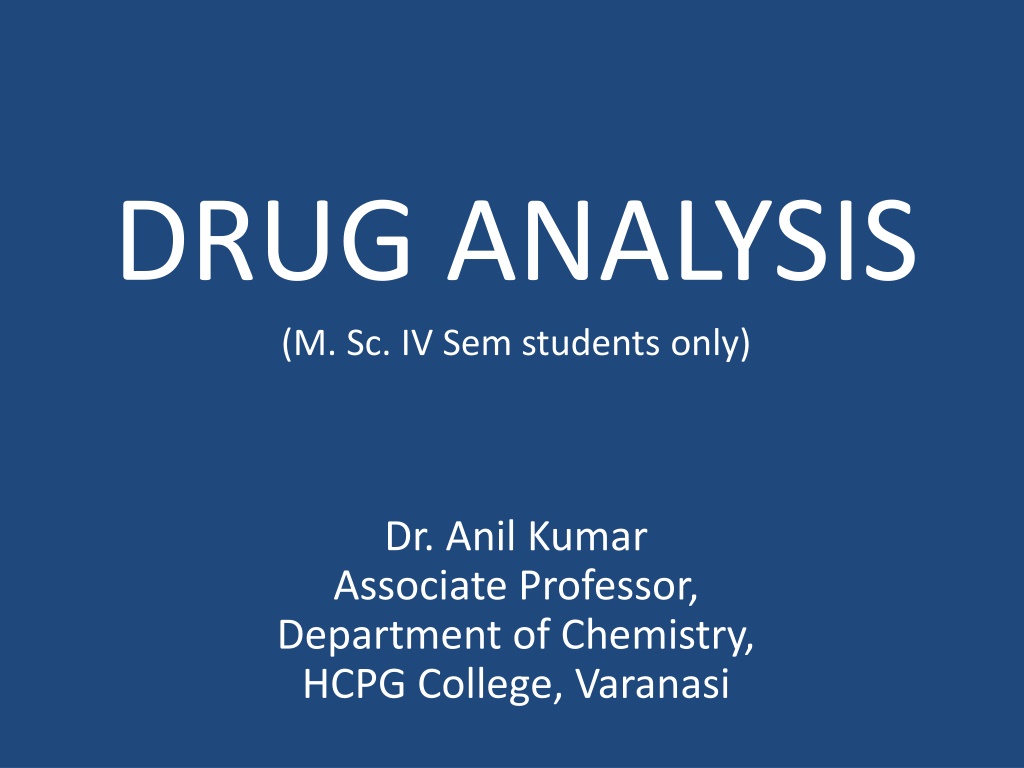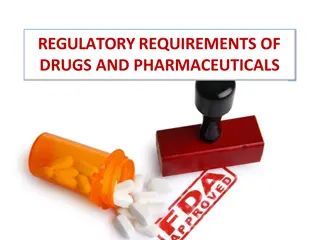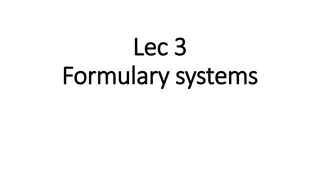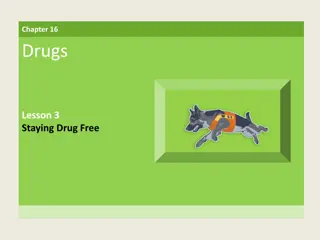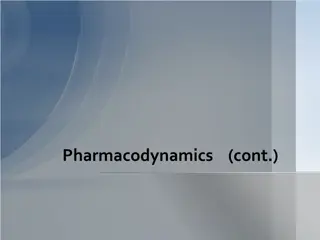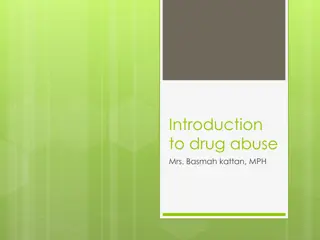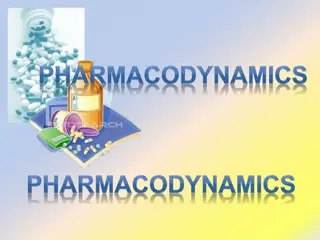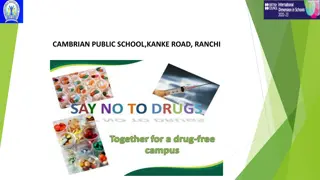Understanding Drug Analysis and Classification
Drug analysis is crucial in identifying and defining substances used for treatment. The definition, characteristics, and classification of drugs are outlined, including chemotherapeutic agents and pharmacodynamic agents. An ideal drug should be localized, non-toxic, efficient, and have minimal side effects. Various chemotherapeutic agents are discussed based on their therapeutic actions. Understanding these concepts is essential for students studying drug analysis.
Uploaded on Sep 07, 2024 | 0 Views
Download Presentation

Please find below an Image/Link to download the presentation.
The content on the website is provided AS IS for your information and personal use only. It may not be sold, licensed, or shared on other websites without obtaining consent from the author. Download presentation by click this link. If you encounter any issues during the download, it is possible that the publisher has removed the file from their server.
E N D
Presentation Transcript
DRUG ANALYSIS (M. Sc. IV Sem students only) Dr. Anil Kumar Associate Professor, Department of Chemistry, HCPG College, Varanasi
Definition of Drug The word drug is derived from the French word drogue which means a dry herb which is no complete and comprehensive definition of Drug. According to some workers, a drug may be defined as a substance used in treatment and cure of disease in animals including men . However according to comprehensive definition, a drug is substance with an abnormal effect on certain body function,e.g. strychnine stimulate the action of heart and aspirin stills its action. Since abnormally, so these compounds are known as drugs. prevention, diagnosis, most acceptable and both of them affect
Characteristics of Drugs An ideal drug should posses a following requirements. The action of ideal drug should be localised at the site where it is desired to act. However no drug has these characteristics. It should be non toxic. It should have minimum side effect. It should not harmful for host tissues or physiological process. It should be efficient. it should not make the host cell resistant to the drug after its use for long time. However most of the drugs do not possesses these characteristics.
Classification of Drugs On the basis of their therapeutic action, drugs are classified in two main categories: (A) Chemotherapeutic agent These drugs are used in the treatment and cure of specific diseases like malaria, syphilis, tuberculosis, micro-organisms infection diseases, etc. Such type of drugs are known as chemotherapeutic agent. These chemotherapeutic agents attack and destroy the invading organisms without injuring or destroying the cell of the infected host. Thus chemotherapy may be defined as the treatment of disease by chemicals which selectively inhibit the parasitic organisms. The first therapeutic agent introduced by Ehrlich in 1910 were certain organo-arsenic compounds against t- sphylis.
Various chemotherapeutic agents: It may further divided into following types- (1) Organometallic therapeutics (2) Anti-malarials (3) Antibacterials (Sulpha drugs) (4) Antibacterials (Antibiotics) (5) Anti-protozoals (6) Anti-fungal (7) Anthelmentics (8) Antiseptics (9) Antineoplastics (10) Antitubercular (11) Antileprosy
(B) Pharmacodynamic agents These drugs have characteristic effect on animal organism but are not specific remedies for particular diseases. Although such type of drugs can assist in recovery from a specific bacterial or viral infection. Their action is not directed at the pathogenic organism which are target in chemotheraphy (This is difference from chemotherapeutic agents and it) Classification of Pharmacodynamic agents (1)Non selective central nervous system (CNS) modifiers i.e. depressant.
(2) Selective modifiers of CNS i.e. tranquillizer. (3) CNS stimulant i.e. antidepressant (4)Adrenergic stimulants i.e. blocking agent (5)Cholinergic and anticholinergic agents (6) Cardiovasculate agents (7) Diuretics (8) Anaesthetics (9) Antipyretics and analgesics (10) Antispasmodix (11) Antihistamines (12) Anticoagulant
Therapeutic Index The medicinal value of the drug is generally represented by therapeutic described as the ratio of amount necessary to kill the patient i.e. maximum tolerated doze (MTD) to that required for maximum curative doze (MCD). index which is Therapeutic index = The value of therapeutic index = 10 means that 10 times a doze used for curative purpose would kill the patient as well as parasite
Analysis technique of drugs We know that a large number of organic molecules absorb radiation in the ultraviolet and visible region. The molecule having high molecular absorptivities may determined directly. These chemically into derivatives which have high molar absorptivity. A single absorbing component can be determined easily by assuming the component to be analysed as the only species that absorbed in sample mixture or if it is only species in the sample that absorb at the wavelength selected analysis. by spectrophotometric can be converted
Experimentally the spectra of the sample is obtained and the wavelength for the Generally the wavelength of maximum absorbance. e.g. a tetracyclene hydrochloride, a drug used as an antimicrobial medicine and as a broad spectrum antibiotics in animal spectrophotometrically by obtaining spectrum of this compound in which absorption maxima are obtained at 220, 268 and 355 nm. The percentage of tetracyclene can determined by preparing a series standard between 10-4to 10-5M. In 0.10 FS solution and the absorbance is determined at 355 nm for each standards. prepared by crushing ten tablets and mixing them homogeneously. A portion of this powder is directly weighed and diluted in.10 F-HCl and the absorbance is determined . The calculation is then calculated by comparison with standard with the help of Standard addition calibration graph. measurement chosen. can be determined The sample may be
Screening and analysis of drugs by Thin Layer Chromatography (TLC) method TLC is good technique for separating and screening the drugs: (A)For checking purity of sample- TLC is mainly used as a check on sample obtained by other method. In this respect, it is high sensitivity often enables impurities to be observed in so called pure samples. (B) Analysis of antibiotics- Tetracyclene have been separated on thin layer of silical gel by using solvent system 10% citric acid, n-butanol- methanol (4:1:2), (4:2:2).
Penicillin have been separated on silica gel (g) by usong two solvents acetone-methanol (1:1) and isopropanol-methanol (3:7). The detecting or visualising agent is the iodine-azide reaction was employed by spraying the dried TLC plates with a 0.1N iodine solution containing 3.5% sodium azide. Neomycin sulphate have been separated on layers of activated carbon. Both acidic and neutral layers were used. Active carbon separation of water soluble basic antibiotics produced by streptomyces. Erythromycin have been separated on the layer of silica gel (g) using a solvent composed of CH3Cl, CH3OH, benzene-formamide (80:20:20:2.5). is absorbed for
Analysis of Drugs by Gas Chromatography A large number of pharmaceutical products (drugs) have been separated by Gas chromatography and identified by IR, NMR, UV and Mass spectrometer techniques. This technique of separation is similar to liquid-liquid and liquid- solid chromatography except that in gas in chromatography the mobile phase is gas rather than liquid. The stationary phase can be powdered solid when the technique is called is called gas-solid chromatography (GSC). If the stationary phase is liquid coated on solid particle, chromatography (GLC) is used. In GLC a column is used which is packed with solid particle acting as a support for stationary liquid phase. For separating particular component, the nature of solid support and of liquid phase, method of packing the column, length, diameter and temperature of the column are the factor which must be taken into account the term gas-liquid
The entire column is heated to suitable constant temperature. The mobile phase is gas called carrier gas. The carrier gas used is either helium, nitrogen, argon or hydrogen. The sample solution is introduced from top of the column. The carrier gas at constant pressure regulated by flowmeter is also send through the column. The compound that is held less strongly by the stationary phase moves more rapidly along with carrier gas and then different component get separated. The gas coming out of column is sent to thermal conductivity detector chromatogram showing the various component present in test sample. which record the
Narcotics and dangerous drugs Narcotics analgesic Morphine is the natural product prototype for the class of analgesic. It and its congeners are called opioids, narcotics, narcotic analgesic and centrally active analgesic. They modify the effect of pain impulse on the CNS.
Awareness of the pain may persist or diminished but the ability to interpret, integrate and react to pain is decrease with attendant and sedation euphoria and reduced anxiety and suffering. The only other useful effect of opioid on CNS is cough suppression. Peripherally reduction in the propulsive movement of the intestine is useful in control of certain diarrhea but otherwise constipation of common side effect. Among the host of adverse reaction the most critical in limiting usefulness of opioids are centrally mediated tolerance, dependence, and respiratory depression, which is cause of death from opioid overdose.
Tolerance refer to the need to increase the over doze of opioid over a period of time to achieve same level of analgesia or euphoria. A return toward normal sensitivity occurs after a free drug period. Psychological and physical dependence developed upon extended use of narcotics. Psychological dependence is characterized by drug seeking behaviour directed toward achieving euphoria and escape from psycho- socio-economic pressure. They derive may become social, legal and ethial consideration offer no difference to inwardy and outwardy, behaviour and crabing. Physical behaviour is gradually manifested after stopping narcotics use. Depending upon the drug to which its dependence have been established and the duration of use and dose, symptoms of withdrawal vary duration and severity. so consuming that normal directed destructive in number and kind
The most common symptoms include annorexia, weight loss, pupillary alternatively with abdominal cramps, vomiting , lachrymation and increase heart rate. Narcotics antagonists are valuable adjunct to therapy. They are used in monitoring and assuring patient , compliance during and after counselling because they block euphoria but its overdose is dangerous for health. dilation, chills, excessive sweating,
Use Mask and maintain social distancing And join Arogya Setu App THE END THANKS
